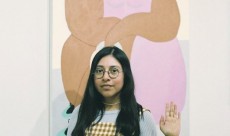Our Body Issue: リリアン・マルティネス/Interview with Lilian Martinez “すべての女性たちが私の絵の中に自分の強さや美しさを見出してくれるといいなと思います”
NeoL / 2019年6月1日 12時0分
Our Body Issue: リリアン・マルティネス/Interview with Lilian Martinez “すべての女性たちが私の絵の中に自分の強さや美しさを見出してくれるといいなと思います”
ポップカルチャーのシンボルや古典的な彫刻や花瓶のイラストが描かれた、どこかシュールなブランケットで多くの人をとりこにするロサンゼルス発のブランド、bfgf。そのファウンダーであるメキシコ系アメリカ人のアーティスト、リリアン・マルティネスが、約1年半ぶりとなる日本での個展を開催した。主に有色人種の女性が描かれた独特な世界観の絵画が展示された会場のgallery commune(東京・幡ヶ谷)にて、アーティストになった経緯や作品制作に込めた思いをたっぷりと聞かせてもらった。 (→ in English)
――ロサンゼルスをベースに活動されているそうですが、出身はどちらですか?
リリアン「シカゴで生まれました。両親はメキシコ人で、兄弟もみんなメキシコで生まれたから、私は家族の中で唯一のアメリカ生まれ。シカゴにはかなり長い間住んでいて、シカゴ美術館付属大学を卒業した後もシカゴに残って、あらゆる仕事をしていました。私は写真専攻だったから、自分が何をしたいのか見つけるために、写真関係のいろんな仕事を試していたんです」
――絵ではなくて写真の勉強をしていたんですね。
リリアン「自分にとって、写真が一番理解しやすいものだったんだと思います。初めて興味を持ったのが写真なのだけど、ずっとイメージを作りたいという願望があって。写真は一番理解しやすそうだったし、私にも学べるんじゃないかと思ったんです。それまで絵を描いていたわけではないから、アートは全然知らなくて。子どもの頃に触れる機会もなかったですし」
――そうだったんですね。
リリアン「アーティストになる人は、生まれつきアーティストなんじゃないかと思っていました。アーティストになる術を学ぶのではなくて、最初からアーティストなんだ、って。どのような過程が必要なのかを理解していなかったのです。だから大学では、自分が最初に興味を持った写真の勉強をしました。でも自分が求めているような写真が全然撮れなくて、すごく大変でした。いつも変えたくなるようなディテールがあって、そのためにはフォトショップを使うかセットを作るかしかないんだけど、それも違和感があって。絵は4年ぐらい前にロサンゼルスに引っ越してから描き始めました。かなり最近のことなんです」

――LAに引っ越した理由は?
リリアン「夫のダニエルがLAで仕事をすることが多くて、彼が行くたびに私も一緒に行っていて。それに、新しいことに挑戦するのは楽しいでしょう。当時は絵を描いていたわけでもなかったから、本当はもっと写真を追求しようと思っていたけど、いざLAに移ったらそういう気分じゃなくて、それで絵を描き始めました」
――ご自身のブランド、bfgfはいつ始めたのですか?
リリアン「シカゴにいる頃です」
――絵を描くよりも前に始まったのですね。
リリアン「ええ。長年写真をやっていたから、最初は手で触ることができるものを手がけたいと思って。スクリーン上の平面的なデジタル画像ではなくて、触ったり使ったりできるものがよかった。本当はオリジナルの生地をプリントして、バッグとか洋服を作りたくて。でも、当時は今ほど簡単に生地をプリントすることはできなかったから、版画とかスクリーン印刷とか試して、自分が本当に気に入る生地を模索していました。実は裁縫もしていて、バッグやトップスやポーチなどを作っていたんです」
――裁縫もできるんですか?
リリアン「最高の仕立て屋とまではいかなくとも、縫うことはできます(笑)。でも、裁縫はたくさんの労力を要するから大変でした。すごくたくさん時間を費やしても、あまり稼ぎにはならなくて。デザインすることよりも、実際に作品を作ることにたくさんの時間を費やしていました。それでLAに引っ越す1年くらい前から、デジタルで絵を描くようになりました。そしたら友だちから、『織布製のブランケットを作るべきだ』と言われて。最初はそんなことできたらすごいなって思っていました。そんなものが作れる場所があるとは知らなかったから。でもできるところがあると知って、実際に作ってみて、それ以来ずっとその会社と仕事をしています」

――ブランケットに施されたアートでは、90年代のポップアイコン的要素が花瓶や彫刻といったものと並んでいるのがいいですね。
リリアン「90年代のポップアイコンについては、私が90年代育ちだからだと思います。それから、移民二世としての経験も関係しているはず。自分の好きなものをすべてかき集めて組み込んでいるんです。両親が教えてくれたすべてのことに加えて、テレビや学校で学んだすべてのことをね。今でも共鳴できるような子ども時代のものと、建築やアートなど、今の私が興味を持っているものとのリミックスのような感じがします。これはある意味、自分にとって大切なものや美しいもののコンビネーション。その結果に人々がつながりを感じてくれて、とてもラッキーだと思います。多くの人は同世代で、私と同じようなものや同じような興味を持っていたんじゃないでしょうか」
――アートを施すプロダクトは、どのように選んでいるのですか?
リリアン「実用的だけど美しくて、家にあったら幸せな気分にしてくれるんだけど、毎日使うことができるもの。ブランケットはピクニックに持って行ってもいいし、大きなアートピースのように壁に飾ることもできる。もしこんなに大きな絵画を買うとしたらとても高いだろうけど、これなら手頃に日々の生活にアートや美を取り入れることができるから。それは私にとってはすごく重要なことなんです。アートは私の生活をハッピーにしてくれるから、他の人にも提供したいと思います」
――今回初めてあなたの絵画を拝見したのですが、すごく素敵ですね。この絵の世界に住みたいと思いました!
リリアン「私も! だからこそ絵を描いているんだと思うんです。多くの女性から、『こんな世界に住みたい』と言われます。それは私も同じで、女性にとって、特に有色人種の女性にとって、美しくて平和で完璧な世界を作ろうとしているんだと思います。それは現実では目にしないことだから。いつも何かがおかしいというか」

――4年前に絵を始めたとのことですが、独学なのですか?
リリアン「独学です。実は最初は描き始めるのがすごく怖かった。なぜだかはわからないけど、私にとっては怖いことだったんです。だけど、いざ描き始めたらとにかく楽しくて、良い気分になりました。自分をハッピーにしてくれるから私は絵を描くんだと思います」
――ここに描かれた女性たちは小さな頭に大きな体が特徴的です。パワフルだけど柔らかくもあり、力強い中にもたくさんの光を感じます。あなたが絵を通して表現したいことは?
リリアン「まさにその通り。私は彼女たちを強くも柔らかくも見せたいんです。私にとっては、大きな肩は強さを表しています。そして小さな頭は彼女たちを美しく見せるだけでなく、中性化しているのです。彼女たちは、ただこの平和な場所に存在している。色も非常に重要で、自分にとってしっくりとくる完璧な色のコンビネーションを見つけたいと思っています。これらの色もまた、とても力強くもあり、柔らかくもある。力強いにもかかわらず、どこか柔らかくて穏やかなのです」
――有色人種の女性を描く上でのインスピレーションは?
リリアン「おかしなことに、絵を描き始めたときは『褐色のボディや有色人種の女性だけを描こう』とは思っていませんでした。ただ自然にそうなったという感じ。でも、たくさんの作品を手がけるようになって、なぜ自分がこのような作品を作っているのか、よく考えるようになりました。私はすごく肯定的な観点で、白人以外の女性たちが興味深い形で表現される姿を見たかったんだと思います。彼女たちは必ずしもメキシコ系とは限らないし、いろんな国籍やミックスかもしれない。ただ白人ではない女性だというだけ。でももちろん、すべての女性たちが私の絵の中に自分の強さや美しさを見出してくれるといいなと思います」

――今回の個展はなぜ「Rosa Mariposa」と名付けたのですか? ピンク色の蝶という意味ですよね?
リリアン「実は”Rosa”はローズをイメージしていたのだけど、どちらの意味でも通じると思います。それをピンク色の蝶と解釈してくれる人がいて、すごくいいなと思いました。(タイトルは)とにかく遊び心があるし、楽しい響きだなと思って。本当にこのタイトルでいいのか、遊び心が強すぎなんじゃないかと迷っていたんだけど、個展のための作品制作を始めたときに、メキシコから飛んで来た大量の蝶がカリフォルニアを通過したんです。スタジオからの帰りに高速道路を運転していたら、蝶が飛んでいるのが見えて。都会の中でたくさんの蝶を見るのは、すごく変な気分でした。毎年移動していると思うんだけど、今年は特に蝶が多かった。雨がたくさん降って、花がたくさん咲いたから。あとは、作品の制作中にプリンセス・ノキアをよく聴いていたんだけど、“Biohazard Butterfly”という曲があって。汚染された街にいる蝶のことを歌った曲で、ちょうどいいと思ったんです。それでこのタイトルにしようって決めました(笑)」
――インスパイアされたアーティストや、尊敬しているアーティストはいますか?
リリアン「マティスの作品の持つ喜びやパレットが大好き。あとはイギリスの彫刻家のヘンリー・ムーアも大好きです。彼は女性の体を形取った大きな彫刻をたくさん作ったのだけど、そのすべてが少しだけ抽象的なところがすごく好き。でも全体的に建築からの方がインスパイアされている気がします。建築物のディテールや色を見るとインスパイアされるんです。東京を散歩していても、いろんな色や形の建物を見ることができる。私は日々の生活で目にするものに、すごくインスパイアされるんです」
――将来的にはどのようなことに挑戦したいですか?
リリアン「大規模な屋外のインスタレーションを手がけてみたい。家具やアニメーションもやってみたいです」
――今回の個展によって、日本にはさらにファンが増えたのではないでしょうか。あなたの作品を見て、どんなことを感じ取ってほしいですか?
リリアン「とにかく良い気分になって、エネルギーを感じて、インスパイアされてくれたら。ある男性から『力をもらったよ!』と言われて、すごくうれしかった!それはまさに私が感じてほしいことなんです。言語や言葉を使わずに観客に語りかけ、彼らとコネクションが持てたらいいですね」

photography Shiori Ikeno(portrait)Keisuke Tanigawa(still)
text Nao Machida
edit Ryoko Kuwahara
Lilian Martinez | リリアン・マルティネス
1986年生まれ。シカゴ美術館附属美術大学写真科を卒業後、 LAに移りアーティスト活動の傍ら2010年 アートブランド 「bfgf」を立ち上げる。デジタルプロダクトの他、紙やキャンバス、リネンへのペインティング、セラミック作品も制作している。 http://www.lilianmartinez.com https://www.instagram.com/bfgf/
(This interview is available in English)

――I heard that you are based in Los Angeles. Where are you from originally?
Lilian Martinez: “I was born in Chicago. My parents are Mexican and all my siblings were born in Mexico. So I'm the first one in my immediate family to be born in the United States. I stayed in Chicago pretty long, went to college there at the School of the Art Institute. And after that I stuck around, kind of working odd jobs. I studied photography so I did some weird photo jobs trying to figure out what I wanted to do.”
――So you studied photography not painting or drawing?
Lilian: “Yeah. I think that was the easiest thing for me to sort of wrap my mind around. It was like the first thing that interested me, and I think it was because I always had this desire to make images. And that seemed like the most accessible thing, I felt like I could learn how to do it. Because I didn't really draw, and I didn't know about art really. It wasn't introduced to me as a child.”
――I see.
Lilian: “It almost felt like if you are an artist, I feel like this ordained thing like, there is a born artist. You don't learn how to become an artist you just are an artist. I didn't really know what the process was. I studied photography and that was like the first thing that really interested me. So I went to college for that. And it was really tough for me because I felt like I could never capture exactly how wanted it to be. There were always some details I wanted to change, but the only way to change it would be to photoshop it or to make a set or something, and it really didn't feel right. And then, when I moved to LA, maybe like four years ago, I started painting. It's been pretty recent.”

――What brought you to LA?
Lilian: “My husband, Daniel was working a lot there, so whenever he would go I would go with him. And it's just fun to try something new. We were actually going to pursuit photo more, because I wasn't drawing or anything at the time. But then, we got there and it didn't feel right, so I just started drawing.”
――When did you start bfgf?
Lilian: “I started bfgf when I was in Chicago.”
――So you started it before you started painting?
Lilian: “Yeah. At first, I really wanted to work with more tactile objects, because I had been doing photography for so long. So I wanted stuff you can touch or use, not just flat digital on a screen. And actually I wanted to print my own fabrics and make book bags and clothes and stuff. But it wasn't as easy to print fabric back then, I feel like. So I was really experimenting with block printing or screen printing and finding fabrics that I really love. And I was actually sewing a lot. I was making bags and tops and purses.”
――Can you sew, too?
Lilian: “Well, I'm not like the best sewer but yeah, I can do it [laughs.] But it was really hard because sewing was so labor-intensive. I was spending so much time, but I wasn't making enough money. And I felt like so much time was invested in actually producing the pieces as oppose to designing them. So then, maybe like a year or so before we moved to LA, I started drawing digitally more. And my friend was like ‘you should try making these woven blankets.’ At first I was like, yeah that would be amazing. I didn't know there is a place you could make it. So I did it. Now I've just been really working with them.”

――I love how you put the 90's pop icons with vase and sculptures in your design for woven blankets.
Lilian: “I think a lot of the 90's stuff is from me just growing up in the 90’s, and also being the second generation immigrant experience. You are just taking everything you like, and sort of incorporate into this. All of the stuff my parents have taught me, but then also what I'm learning from TV and from school. And I feel like it's just really like a remix of things that still resonate with me from my childhood mixed with things that I'm really interested in now, like architecture and art. So it's kind of like this combination of everything that's important and that I think is beautiful. And I feel really lucky that people connect with it. I feel like it's probably a lot of people that are my age that are adults now, but that grew up with the same stuff and had a lot of the same interests maybe.”
――How do you select the products that you want to make with your art?
Lilian: “I want the stuff that you can use, but that's still going to look beautiful, and still going to make you happy to have in your home, but you are going to be able to use it everyday. Like the blankets, you can take it on a picnic or you can hang it on your wall like a large piece of work. If you bought a painting that big that would be super expensive, so it's like a really more accessible way to introduce art and beauty into your everyday life. I feel like that's really important for me to have. In my life, it makes me happier, so I hope that I can bring that to other people.”
――This is my first time to see your paintings, and I love them so much. I feel like I want to live in this world!
Lilian: “Yeah, me too! I think that's why I make it. A lot of women tell me ‘oh, I wish I lived in this world,’ and I feel the same way. I feel like I'm really trying to create a world that's beautiful and peaceful and perfect for women, especially women of color. Because I feel like I don't see that in reality. There is always something weird, you know?”

――You mentioned that you started painting four years ago. Did you teach yourself how to paint?
Lilian: “I just taught myself. I was actually really scared just to start painting. I don't know why but it was terrifying to me. And I started doing it and it was just so fun, made me feel so good. I feel like I do it because it makes me happier.”
――I love how you paint women with a small head and large body. I feel so much power but also at the same time, they are so tender. They are so bold and there is so much light in it. What would you like to express through your painting?
Lilian: “I feel like that's exactly it. I want them look strong but soft. I feel like the shoulder kind of like portrays to me like strength. And then I feel like having the head smaller, they look really beautiful like that, but also kind of like desexualizes them. They just exist in this really peaceful place, you know? I feel like color is also really important to me to find the perfect color combination that feels right to me. The colors also are very strong, but they are soft. There is something soft about them and calming about them even though they are bold.”
――What inspires you to paint women of color?
Lilian: “It's weird because when I started painting, it wasn't like, ‘oh I'm only going to paint brown bodies or women of color.’ I just did it. It would just sort of naturally happen. As I started to make more work, then I started really to think about it, like ‘why am I making this kind of work?’ I think it's because I wanted to see women of color represented in really positive light and in an interesting way. So I feel like these women aren't necessarily Mexican, they can be any nationality or mixed. I think they are just non-white women, you know? But I want all women obviously to be able to see their strength and their beauty mirrored in the images.”

――Why did you name this show "Rosa Mariposa"? Does it mean pink butterfly?
Lilian: “Well, actually, I was thinking ‘Rosa’ like a rose, but it can mean both. And actually I was like, oh that's really cool that how people interpreted as pink butterfly instead of rose butterfly. It just sounded playful and fun. I was like, ‘should I name it this? Is this too playful?’ But then when I started making the work for the show, there was a huge migration of butterflies coming through California from Mexico. So we would drive down the highway from my studio, and then you would see them flying. And it was just so strange to see them in a city setting, so many of them. I think it happens every year, but this year was extra, there were more because of all the rain that happened and there were more flowers. So I think they were more present. And then also, I was listening to Princess Nokia a lot while I was making the work, and there is a song called 'Biohazard Butterfly.' It's all about butterflies in this polluted city, and it just made sense. I was like ‘ok, I'll just name it this’ [laughs] It fits.”
――Who are some of the artists you are inspired by or look up to?
Lilian: “I really like Matisse, like the joy in his work and the palette. And I really like Henry Moore. He's an English sculptor who made a lot of large-scale sculpture of female body, and they are all a little bit abstracted which I really like. But I feel like over all, I'm really inspired more by architecture, like seeing the details and colors in architecture. Even here, just walking around in Tokyo and seeing different colors of the buildings and the shapes, I feel like that's really inspiring. I get inspired by sort of like everyday things that you see.”
――What would you like to try in the future?
Lilian: “I would like to make large-scale outdoor installation. I would love to do furniture and animation.”
――I think through this show you have more fans in Japan now. What would you like them to feel when see your work?
Lilian: “Just feeling good and energized and inspired. There was a guy met and he was like 'it gives me power!' That was so nice! That's exactly how I want them to feel, like a connection, you know? To speak to them without using language or words, just to make that connection with them.”

photography Shiori Ikeno(portrait)Keisuke Tanigawa(still)
text Nao Machida
edit Ryoko Kuwahara
関連記事のまとめはこちら
https://www.neol.jp/art-2/
この記事に関連するニュース
-
「私たちを人間として扱ってほしい」やまぬ爆撃、家族との別れ…ガザ脱出の友人を探し記者がエジプトへ「戻りたいけど誰も戻れない」【脱出者が語る惨状】
北海道放送 / 2025年1月18日 9時45分
-
旅行者はGoogleを活用し続けつつ、AI生成のソーシャルメディアコンテンツにも肯定的
PR TIMES / 2025年1月14日 10時45分
-
この英語ってどんな意味?「 plot twist 」
OTONA SALONE / 2025年1月11日 7時0分
-
英語で「外国人観光客」はなんて言う?
OTONA SALONE / 2025年1月2日 7時0分
-
Shareholder Proposals to Japan Business Systems, Inc.
PR TIMES / 2024年12月22日 14時40分
ランキング
-
1「メニューしょぼくなりすぎ」「粉チーズ有料とか…」サイゼリヤ“不満噴出でも最高益”の矛盾のワケ
女子SPA! / 2025年1月18日 8時47分
-
2太陽光パネルの買い換えは高額だと思うのですが、それに見合うメリットはあるのでしょうか? また、補助金などは出ないのでしょうか?
ファイナンシャルフィールド / 2025年1月18日 3時50分
-
3「新千歳空港まで迎えに来て!」180km離れた旭川に住む友人を“パシろうとする”カップルの末路。ほかの友人たちにも見放されたワケ
日刊SPA! / 2025年1月17日 8時51分
-
4“あおり運転”してきた黒いハイエースの意外すぎる正体。運転手が青ざめた表情で平謝りするまで
日刊SPA! / 2025年1月21日 8時52分
-
5「フジテレビ問題」の根源は"経営不在"にある 2010年代から「一人負け」に陥ってしまった
東洋経済オンライン / 2025年1月21日 9時20分
記事ミッション中・・・
記事にリアクションする
![]()
記事ミッション中・・・
記事にリアクションする

エラーが発生しました
ページを再読み込みして
ください










